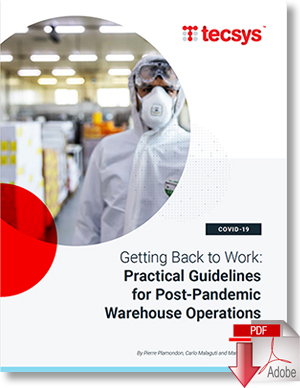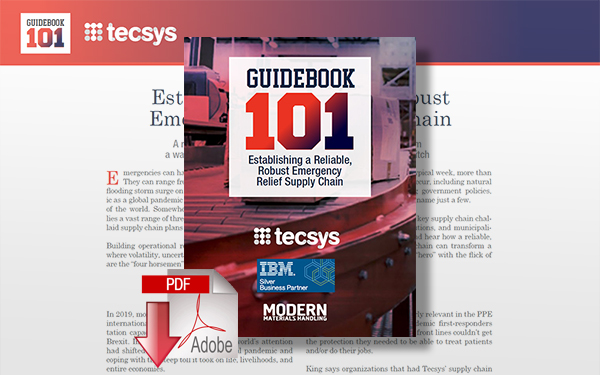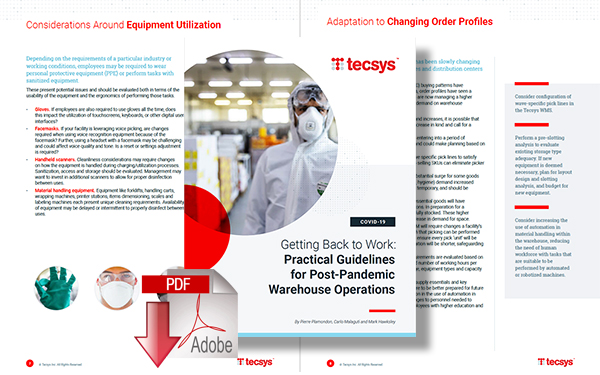Warehouse ‘Just in Case’ Safety Stock - Balancing Inventory Levels vs. Risk

Most organizations try to carry as little safety stock as possible because of the drain it puts on capital, but as we enter the post-pandemic phase, many organizations are looking back and realizing their supply chains are rather brittle.
Supply Chain Risks
There are many risks you need to factor into your supply chain strategy.
Safety stock has always played a vital role in protecting your organization.
Whenever there is an increase in demand or a delay from your supplier, safety stock ensures your business continuality and customer satisfaction.
With the advent of COVID-19, many organizations are reassessing what is a viable safety stock level to hold in their warehouse and how frequently replenishments need to occur.
Do You Need To Be Revising Your Approach To Safety Stock?
Traditionally, an organization defines its optimum safety stock level on goods by analyzing variations in demand history to provide an indication of the safety stock needed to maintain the desired service level.
Another factor is variations in lead time. Planners use tools to assess the likelihood of a stock-out based on these statistics and set safety stock thresholds accordingly.
Mathematically speaking, planners look at the extent to which an event, in this case, a stock-out, is likely to occur. Most organizations try to carry as little safety stock as possible because of the drain it puts on capital.
As we enter the post-pandemic phase, many organizations are looking back and realizing their supply chain is rather brittle.
Up until COVID-19, we were living in the Amazon era of being able to get an endless supply of whatever we need - and getting it quickly too. Organizations rarely were considering item safety stocks with a factor of ‘what would happen if we ran out.’
Even replenishment frequencies were seldom considered with a mind to ‘what would happen if this shipment was disrupted.’ Organizations and consumers alike got comfortable knowing items would generally just get here.
What Are Leading Companies Doing Now?
Today leading organizations are examining all the connections and variables in their supply chains.
To be competitive in unstable market conditions, a company must look at several factors in its supply chain strategy and identify any gaps.
To help get you started, here are three things you can do right now:
- Review your item forecasts and factor in a risk to cost aspect around the impact on the business if that specific item supply was disrupted. It’s important to periodically review your safety thresholds. As conditions change, so should your safety thresholds. Have your system notify you when an item’s replenishment rules have not been examined for some time.
- Consider alternate supply origins to switch to if a disruption occurs. Diversification can be a powerful remedy to supply chain disruption risk, but it is not without side effects. Oftentimes there is an increase in costs and complexity. Before making a decision, take the time to compile your supply options on certain items along with the pros and cons of diversification.
- Plan end-item-level substitution for key products. It might not be necessary to carry as much safety stock if you are able to rely on the inventory of a substitutable item to satisfy demand and to prevent the loss of sales due to the stock-out of a particular item. Finding substitutes that can replace a family of products is the ultimate find and can have significant cost savings to offset potentially a more expensive item.
Supply chains today are complex, vast, and extensive. Don’t wait to start thinking about inventory buffers, supply origin, and alternate supply. Judicious planning now could save a lot of stress later if a further disruption occurs.
Visit: Resources to Achieve Supply Chain Greatness
Related Resources
Establishing a Reliable, Robust Emergency Relief Supply Chain
In this guidebook, we explore the key supply chain challenges that organizations face when disaster strikes and hear how a reliable, robust emergency relief supply chain can transform a warehouse or DC from “zero” to “hero” with the flick of a switch. Download Now!
Practical Guidelines for Post-Pandemic Warehouse Operations
Find out the action items your organization may want to consider as you mount your reopening strategy. Download Now!
More Resources from Tecsys
Article Topics
Tecsys News & Resources
Tightening up on inventories Tecsys announces winners of its 2023 Supply Chain Excellence awards Tecsys launches Innovation Lab focused on applying emerging supply chain technologies Emerging AI Regulatory Ecosystems: Implications for Businesses and Regulators The pluses propelling cloud warehouse management systems (WMS) Five Real-World Digital Twins in the Warehouse User Cases SVT Robotics delivers rapid automation integration for Tecsys WMS customers More TecsysLatest in Warehouse|DC
European Parliament Passes New Law Requiring Supply Chain Accountability Talking Supply Chain: Understanding the FTC’s ban on noncompetes North Carolina Welcomes Amazon’s Newest Mega-Warehouse SAP Unveils New AI-Driven Supply Chain Innovations U.S. Manufacturing is Growing but Employment Not Keeping Pace Maximize Warehouse Space with Mezzanine Automation: Expert Tips Most Companies Unprepared For Supply Chain Emergency More Warehouse|DC
















